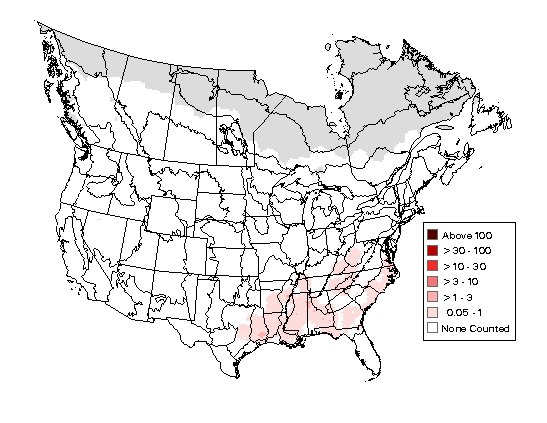Birdfinding.info ⇒ Uncommon, local, secretive, and hard to find across most of its range. When singing on its breeding territory, however, it announces its presence clearly and responds promptly to playback of its distinctive song. Breeds in largely impenetrable habitats: brushy swamps, canebrakes, Appalachian rhododendron thickets, and—as recently discovered—dense stands of young pine. (See maps of breeding areas in the Notes below.) On its wintering grounds it seems to favor habitats of similar structure, but is much more difficult to locate and observe without the aid of its song.
Swainson’s Warbler
Limnothlypis swainsonii
Breeds in the southeastern U.S. Winters in the West Indies and Yucatán Peninsula.
Breeding. Breeds in bottomland swamps, Appalachian rhododendron thickets, and other humid woodlands with dense undergrowth in the southern tier of states from eastern Texas to northern Florida, and north to southern Missouri, southernmost Illinois, central West Virginia, and southeastern Virginia; with a small outpost population on the Delmarva Peninsula in Delaware and Maryland.
Recent research indicates that Swainson’s Warbler readily adapts to breeding in monoculture pine plantations, which are a significant and expanding use of land across much of its range (see Expansion of Swainson’s Warbler Breeding Populations into Commercial Pine Plantations in Notes, below).
Nonbreeding. Winters mainly in humid tropical forests of Campeche, Quintana Roo, Belize, northern Guatemala, Cuba, the Cayman Islands, and Jamaica. Occasional on other Caribbean islands.
Movements. A short-distance migrant that is seldom seen on migration—evidently tends to fly nonstop between breeding and wintering grounds—but is sometimes grounded in “fall-outs” at coastal sites such as High Island, Texas, and Dauphin Island, Alabama.
Each year some individuals overshoot the breeding grounds and briefly attempt to establish territories. The most distant overshot records are from New Mexico, Colorado, Nebraska, Wisconsin, Ontario, and Massachusetts.
Identification
An inconspicuous, cryptically colored warbler with a remarkably long, pointed bill and flat-headed profile. Except when singing, it usually remains low in dense undergrowth or on the ground foraging in leaf litter.
Olive-brown above, with a warm-brown or rusty cap, long, wide eyebrow, and dark eyestripe.
Underparts are pale and may appear some combination of whitish, grayish, brownish, and yellowish; slightly darker on the sides. Its legs are pale pink.

Swainson’s Warbler—note long, dagger-like bill, flat-headed profile, and pink legs. (Little River National Wildlife Refuge, Oklahoma; April 14, 2017.) © Charles Lyon
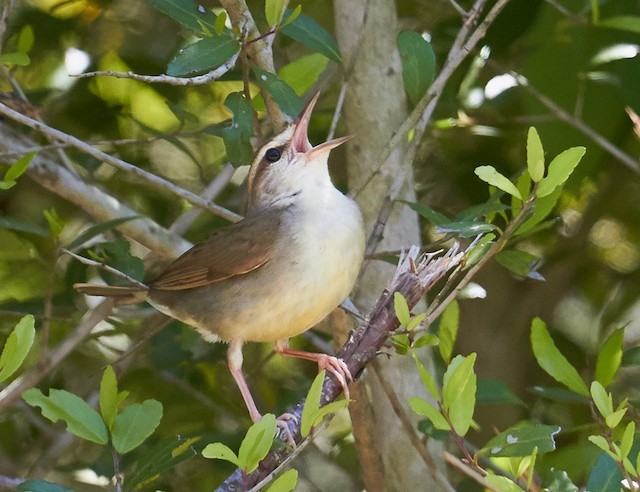
Swainson’s Warbler, with its head thrown back in full song. (Gore Store Road, Village Mills, Texas; April 20, 2014.) © Brooke Miller

Swainson’s Warbler. (Washington Ditch, Great Dismal Swamp National Wildlife Refuge, Virginia; April 14, 2012.) © Mark R. Johnson
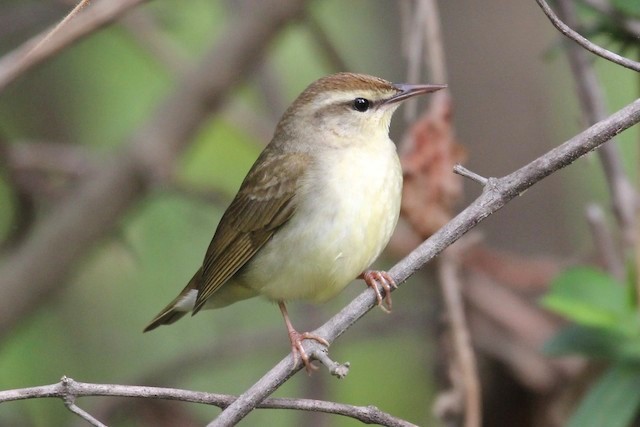
Swainson’s Warbler, showing that the bill does not always appear disproportionately large. (West Columbia Riverwalk, Columbia, South Carolina; April 10, 2018.) © Irvin Pitts
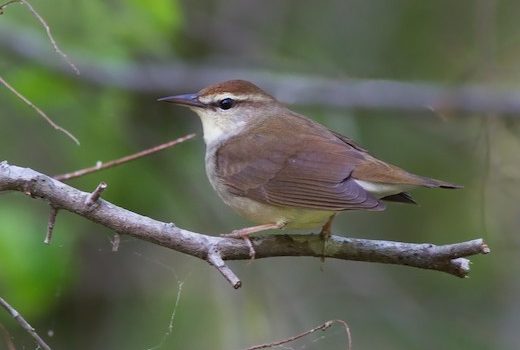
Swainson’s Warbler. (Washington Ditch, Great Dismal Swamp National Wildlife Refuge, Virginia; April 14, 2012.) © Mark R. Johnson

Swainson’s Warbler—note long, dagger-like bill, flat-headed profile, and pink legs. (Lick Creek Park, College Station, Texas; April 13, 2017.) © Ronald Newhouse
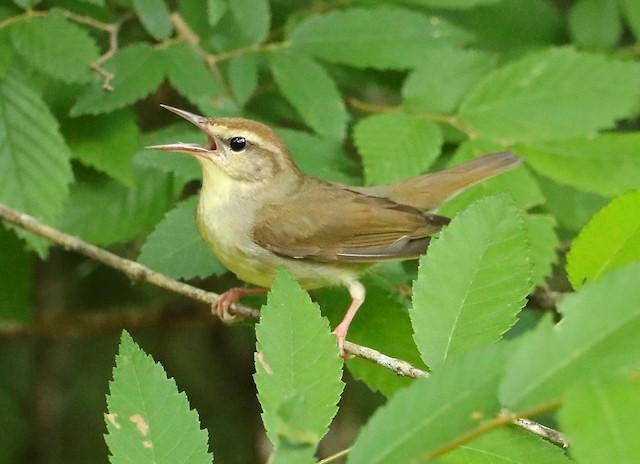
Swainson’s Warbler, singing. (Mundy, Louisiana; May 4, 2018.) © Charles Lyon
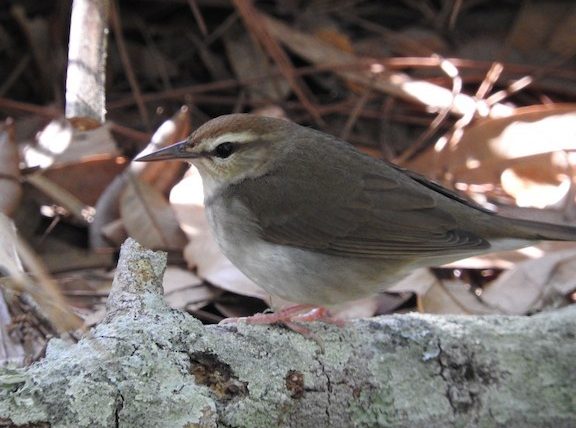
Swainson’s Warbler—note long, dagger-like bill, flat-headed profile, and pink legs. (George C. McGough Nature Park, Largo, Florida; March 27, 2017.) © Wendy Meehan

Swainson’s Warbler, showing underparts coloration at the yellow end of the spectrum. (Cape May, New Jersey; April 29, 2018.) © Dustin Welch
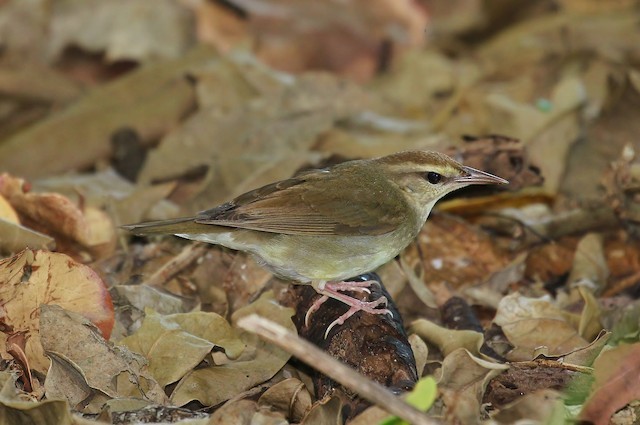
Swainson’s Warbler, in typical foraging habitat. (Fort De Soto Park, St. Petersburg, Florida; April 21, 2016.) © Musa Awan
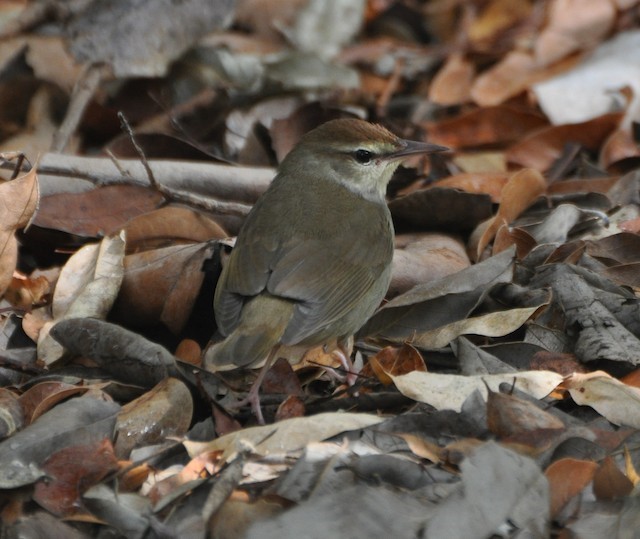
Swainson’s is brownest of the wood warblers. (Fort Zachary Taylor Historic State Park, Key West, Florida; April 12, 2017.) © Tim Healy

Swainson’s Warbler, affording a close study of its formidable, dagger-like bill. © Gary Graves
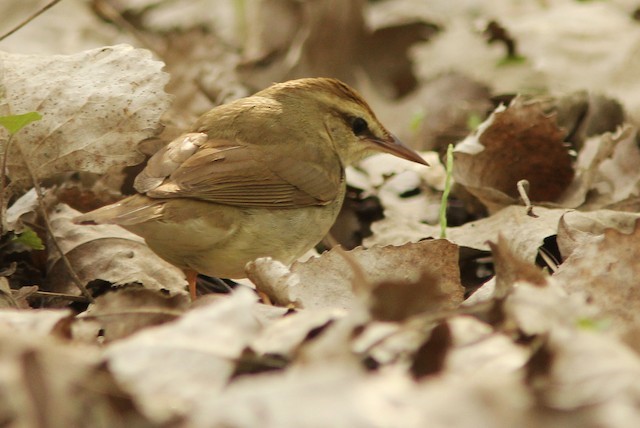
Swainson’s Warbler, in typical foraging habitat. (Tommy Thompson Park, Toronto, Ontario; May 18, 2015.) © David Beadle

Swainson’s Warbler, showing warm-brown crown and atypically rounded head shape with crown feathers raised. (Railroad Ditch, Great Dismal Swamp National Wildlife Refuge, Virginia; May 2, 2014.) © Linda Chittum

Swainson’s Warbler, showing the prey’s perspective on its dagger-like bill. (San Salvador, Bahamas; March 10, 2012.) © Michael Akresh
Voice. Swainson’s Warbler is secretive and rarely seen before being heard. It is best detected by its loud song, which consists of three clear, down-slurred notes that lead into a rapid three-note phrase:
Cf. Yucatán Vireo. Among the birds that regularly occur in Swainson’s Warbler’s range, the ones that most closely share its basic pattern are certain vireos (e.g., Warbling), which differ in having greener, more washed-out coloration, blunter bills, dark gray legs, and arboreal habits. Swainson’s is most similar to the localized Yucatán Vireo—of the Yucatán Peninsula and Grand Cayman—which is browner and longer-billed than most vireos. Leg color is the most reliably unambiguous visual characteristic: pale pink for the warbler, dark gray for the vireo.
Notes
Monotypic species.
Expansion of Swainson’s Warbler Breeding Populations into Commercial Pine Plantations.
Research published by Gary Graves in 2015 indicates that Swainson’s Warbler readily adapts to commercially grown pine plantations where average stand heights of approximately 20 to 30 feet tall, with densities peaking at approximately 24 feet (i.e., 7.5 meters) tall. Most occupied stands are in the range of 8 to 15 years old and include a noticeable incidental presence of broadleaf plants.
Breeding territories have found in such plantations across much of its breeding range, from eastern Texas to southeastern Virginia. The maps below show the locations of Swainson’s Warbler territories discovered in pine plantations (top) and other habitats (bottom) over the course of Graves’s research (but they do not show all locations where Swainson’s Warbler is known to breed).
The unexpected discovery that the uncommon and specialized Swainson’s Warbler adapts to a widely prevalent monoculture appears to indicate that its long-term prospects are secure, as pine plantations cover a large and growing proportion of the land in its breeding range.

References
Alderfer, J., and J.L. Dunn. 2014. National Geographic Complete Birds of North America (Second Edition). National Geographic Society, Washington, D.C.
Dunn, J.L., and K.L. Garrett. 1997. A Field Guide to Warblers of North America. Houghton Mifflin, Boston.
eBird. 2019. eBird: An online database of bird distribution and abundance. Cornell Lab of Ornithology, Ithaca, N.Y. http://www.ebird.org. (Accessed March 29, 2019.)
Fagan, J., and O. Komar. 2016. Peterson Field Guide to the Birds of Northern Central America. Houghton Mifflin Harcourt, New York.
Garrido, O.H, and A. Kirkconnell. 2000. Field Guide to the Birds of Cuba. Cornell University Press, Ithaca, N.Y.
Graves, G.R. 2002. Habitat characteristics in the core breeding range of the Swainson’s Warbler. Wilson Bulletin 114:210-220.
Graves, G.R. 2015. Recent large-scale colonisation of southern pine plantations by Swainson’s Warbler Limnothlypis swainsonii. Bird Conservation International 25:280-293.
Haynes-Sutton, A., A. Downer, R. Sutton, and Y.-J. Rey-Millet. 2009. A Photographic Guide to the Birds of Jamaica. Princeton University Press, Princeton, N.J.
Heckscher, C.M., and J.M. McCann. 2006. Status of Swainson’s Warbler on the Delmarva Peninsula. Northeastern Naturalist 13:521-530.
Howell, S.N.G., and S. Webb. 1995. A Guide to the Birds of Mexico and Northern Central America. Oxford University Press, Oxford.
Latta, S., C. Rimmer, A. Keith, J. Wiley, H. Raffaele, K. McFarland, and E. Fernandez. 2006. Birds of the Dominican Republic and Haiti. Princeton University Press, Princeton, N.J.
Raffaele, H. 1989. A Guide to the Birds of Puerto Rico and the Virgin Islands. Princeton University Press, Princeton, N.J.
Raffaele, H., J. Wiley, O. Garrido, A. Keith, and J. Raffaele. 1998. A Guide to the Birds of the West Indies. Princeton University Press, Princeton, N.J.
Townsend, J.M., C.C. Rimmer, J. Klavins, A.K. Townsend, and E.C. Mendoza. 2014. New winter distributional records for Swainson’s Warbler (Limnothlypis swainsonii) in the Dominican Republic. Journal of Caribbean Ornithology 27:36-39.


